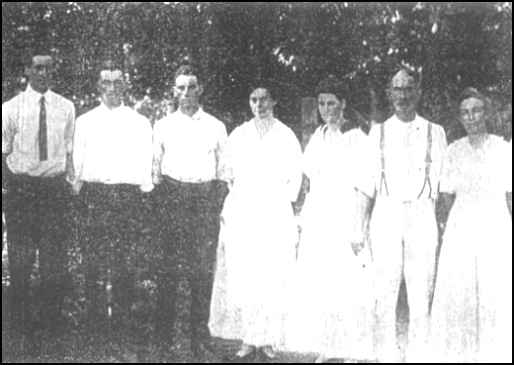
 |
|
WITH FIVE OF 10 CHILDREN ...Son Bill (Far Left in Circa 1915 Photo) Piloted Inventor's 1908 Plane William Massey, Joe, Carrol, Ethel, Abigail, father William Layfayette and mother Lucy Anne. Five other children not shown, George Curtin, Charles Erle, Thomas Edison, Harbert Spencer and Cady. |
|
RECOUNTED BY MEMBERS OF QUICK FAMILY Written by Jerry Wilkerson of the Huntsville Times Sunday, March 5, 1961 "The buzzards is after Will Quick again," some said derisively. But the object of their scorn was too deep in thought to mind. He'd continue lying on his back for hours, under those late-1890 clouds, and watch the big black birds glide gracefully over North Madison County woodlands. He dreamed of manned flights, a had da Vinci, Besnier, and Archytas before him. As he watched the vultures dip to earth, then pull easily back into the skies, he made mental notes on their flight patterns, wing structure, gliding, propulsion, steering. Back at the shop at "Quick's Mill", as the old home place became known, he made other studies. He'd hired a neighbor boy, W. R. Spelce, to catch "snake doctors" -- a nickle each he paid -- and he'd go over their tiny wing rigs with microscopic eyes. "Big Pap" Quick was a man obsessed. He was immersed in ideas only remotely concerned with the economics of raising 10 children on a creek bottom. That was "Big Mama's" department. He'd see a bumble bee, or any of a thousand and one othr insects, "anything that done a good job of flying," a son said, and step into another world. Farmer, sawmiller, blacksmith, scientist, inventor and philosopher Quick had taken his first patent in 1884, on a hillside turning plow he developed at his Molino, Tenn., home. He was now determined to pattent the first motor-propelled, man-carrying aircraft in the world. Neighbors scoffed. sitting on nail kegs around a pot-bellied stove in the community's only store, they speculated about William Layfayette Quick's "notion" and how he was going to get a big hunk of wood and metal to stay in the air. They'd not heard of the Wright brothers. Little had anyone else, except folks near Kitty Hawk, N. C. -- clear across the world from Madison County, Alabama. Not until 1903 did the two Carolina boys begin to create a stir with a briefly successful power-driven flight. And not until 1909 did Wilbur and Orville Wright organize a firm to manufacture their craft. Skilled with his hands, Quick began to assemble a flying machine and within months after the turn of the century he and his sons were conducting tests on propeller shapes, wing contours, and methods of propulsion. The streamlined airplane he developed, with retractable landing gear and a steering tail wheel, incorporated ideas that were to become integral parts of airplane design years later. It is described in patent papers, part of a family collection, as consisting of four bows of wood in a diamond shape, cabled together. The aviator sat in the center of the plane and operated it by tilting his seat, which controlled flexible wings. A twist of the shoulder operated a harness that turned the tail rudder. The finished product was to be powered by a T-model engine in its nose, attached to a single front-mounted prop. Quick was startled to find others already "owned" a great many of his ideas when his attorneys filed for patents. He finally completed his plane, however, in 1908, five years after the Wrights had flown at Kitty Hawk. One of the Quick sons described the plane's maiden flight: "Well, he (William Massey Quick, a son) go in and took off from a pasture, slanting a little down hill. The plane leveled off at about 8 to 10 feet and was doing fine. Then Will saw he was getting to the end of the pasture mighty quick and turned too fast. "The machine tipped down sideways, landed at a slant and the wheels were torn off. We hauled it to the shop and that was the end of it." Parts of the craft still turn up at the old homplace, some say. Quick toyed with the idea of forming an aircraft company in Huntsville, even drew designs for a decorative trade name, Quick Aero Navigation Co., but his zeal had been dented by a flock of aircraft successes across the country. He continued his relish for astronomy and talked of possibilities of life on other planets, even how man would visit them, while his seven sons and a daughter became almost fanatical in their interest in aviation. Led by George Curtis (Curt) Quick, who in 1913 bought a Canadian Army training plane, the youths taught each other to fly and became pioneerrs in southern aviation. The daughter, Cady Quick, now Mrs. Than Franklin of Wichita, Kan., was one of the edtremely small number of woman pilots in the era when Amelia Earhart's name hit headlines with regularity. Thomas (Tom) Edison Quick, also of Wichita, worked with his brother Curt as a pioneer in crop dusting via airplane and in developing a system of insect destruction by covering fields with ladybugs. Charles Erie Quick designed and manufactured a small automobile and did some design work on airplane engines. Joe Quick, recently retired Madison County commissioner, was renowned as a mechanical genius throughout this area and was a stunt pilot for years. Herbert Spencer Quick, Phoenix, Arizona, still works at the ladybug business. The mother of the clan, the former Lucy Ann Maroney, is in her 90's and lives in Wichita. She and Will Quick were married in 1882. Every now and then the Quicks meet at the home in Madison County or Wichita for a family reunion. They relive "Big Pap's" adventures up to the time of his death, January 27, 1927, and the storybook past of the entire family. |


|